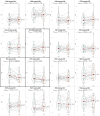Cardiac MRI study of adverse events in patients treated with immune checkpoint inhibitors: a prospective cohort study of cardiac adverse events
- PMID: 40107671
- PMCID: PMC11927457
- DOI: 10.1136/jitc-2024-010568
Cardiac MRI study of adverse events in patients treated with immune checkpoint inhibitors: a prospective cohort study of cardiac adverse events
Abstract
Immune checkpoint inhibitors (ICIs) revolutionized cancer therapy, yet require management of immune-related adverse events (irAEs). Fulminant myocarditis is a rare irAE, but lower-severity cardiac events are being reported more frequently, leading to an unmet need for irAE prevention, early diagnosis, and treatment, especially for long-life-expectancy patients. We recruited 57 patients, stratified according to therapy regime (monotherapy (30%) or combination (33%) cohort) or history of cardiac disease or presence of at least two cardiovascular risk factors other than prior or active smoking (cardiovascular cohort (37%)). We performed a complete cardiological assessment with clinical visit, 12-lead ECG, multiparametric cardiac MRI as well as peripheral blood mononuclear cell immunophenotyping, prior to ICI initiation and around 2 months later. ICI treatment was associated with a significant left ventricular ejection function (LVEF) reduction pre-ICI versus post-ICI treatment (60.1±8% to 58.1±8%, p=0.002, paired t-test) and more than 3% LVEF loss in a substantial proportion of patients (18; 32%). These patients also showed significantly higher T2 values (p=0.037, unpaired t-test), putative sign of cardiac edema. The loss of cardiac function did not differ among patients with different tumor types, therapy regimes or history of cardiac disease. Immunophenotyping analyses showed a reduction of programmed cell death protein 1 staining on both CD4+ and CD8+ T cells, and an upregulation of HLA-DR on CD8+ T cells. Using a very sensitive and comprehensive approach in patients unselected for cardiac history, we found a subclinical but significant LVEF decrease. These findings may inform ongoing discussions on optimal management of cardiac irAEs in patients undergoing ICI treatment and warrant further evaluation.
Keywords: Cardiotoxicity; Immune Checkpoint Inhibitors; Immune related adverse event - irAE.
© Author(s) (or their employer(s)) 2025. Re-use permitted under CC BY-NC. No commercial re-use. See rights and permissions. Published by BMJ Group.
Conflict of interest statement
Competing interests: The authors have no competing interests to declare. EL receives research grants from Bristol Myers Squibb (BMS) on a topic unrelated to this paper, royalties from NIH for a patent on methods to develop T memory stem cells and consulting fees from BD Biosciences, Swarm Therapeutics, Menarini, and BioLegend. AS is a member of Advisory Boards for BMS, Servier, Gilead, Pfizer, Eisai, Bayer, MSD; has consulted for Sanofi/Incyte; has received speaker fees from Takeda, BMS, Roche, AbbVie, Amgen, Celgene, Servier, Gilead, AstraZeneca, Pfizer, Lilly, Sandoz, Eisai, Novartis, Bayer, MSD. MS is a member of Advisory Boards for Incite, GSK; steering committee for BMS; Data Monitoring committee for Sanofi; and has consulted for Incite, GSK.
Figures


References
-
- Rini BI, Moslehi JJ, Bonaca M, et al. Prospective Cardiovascular Surveillance of Immune Checkpoint Inhibitor-Based Combination Therapy in Patients With Advanced Renal Cell Cancer: Data From the Phase III JAVELIN Renal 101 Trial. J Clin Oncol. 2022;40:1929–38. doi: 10.1200/JCO.21.01806. - DOI - PMC - PubMed
MeSH terms
Substances
LinkOut - more resources
Full Text Sources
Medical
Research Materials
